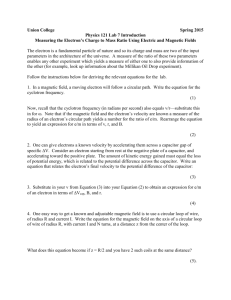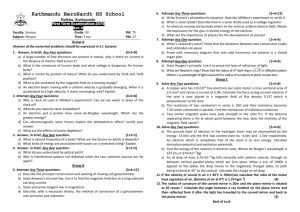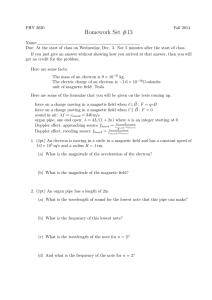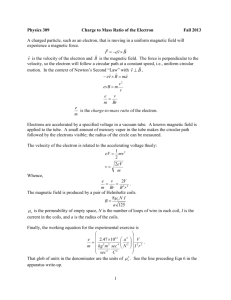GEOPHYSICAL RESEARCH VI. Research Staff Prof. G. Fiocco
advertisement
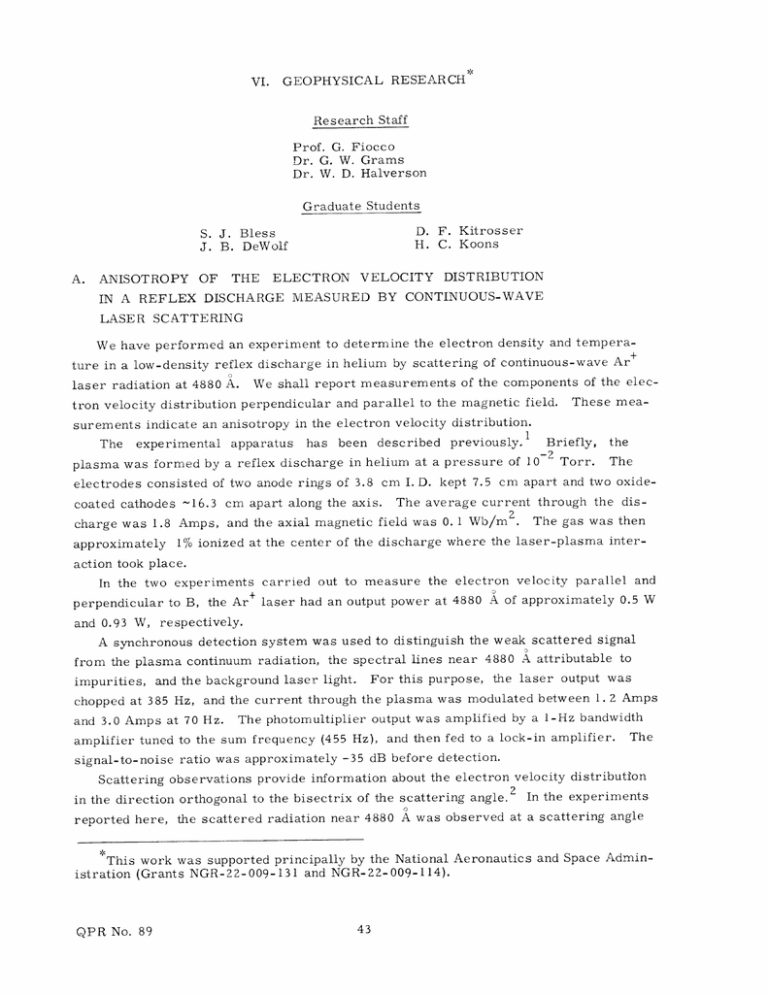
VI. GEOPHYSICAL RESEARCH Research Staff Prof. G. Fiocco Dr. G. W. Grams Dr. W. D. Halverson Graduate Students D. F. Kitrosser H. C. Koons S. J. Bless J. B. DeWolf A. ANISOTROPY OF THE ELECTRON VELOCITY DISTRIBUTION IN A REFLEX DISCHARGE MEASURED BY CONTINUOUS-WAVE LASER SCATTERING We have performed an experiment to determine the electron density and temperature in a low-density reflex discharge in helium by scattering of continuous-wave Ar+ laser radiation at 4880 A. We shall report measurements of the components of the elec- tron velocity distribution perpendicular and parallel to the magnetic field. These mea- surements indicate an anisotropy in the electron velocity distribution. -2Briefly, the plasma was formed by a reflex discharge in helium at a pressure of 10-2 Torr. The electrodes consisted of two anode rings of 3.8 cm I. D. kept 7.5 cm apart and two oxideThe experimental apparatus has been described coated cathodes ~16.3 cm apart along the axis. previously. The average current through the dis- charge was 1.8 Amps, and the axial magnetic field was 0. 1 Wb/m. approximately The gas was then 1% ionized at the center of the discharge where the laser-plasma inter- action took place. In the two experiments carried out to measure the electron velocity parallel and perpendicular to B, the Ar laser had an output power at 4880 A of approximately 0.5 W and 0.93 W, respectively. A synchronous detection system was used to distinguish the weak scattered signal from the plasma continuum radiation, the spectral lines near 4880 A attributable to impurities, and the background laser light. For this purpose, the laser output was and the current through the plasma was modulated between 1. 2 Amps and 3.0 Amps at 70 Hz. The photomultiplier output was amplified by a 1-Hz bandwidth amplifier tuned to the sum frequency (455 Hz), and then fed to a lock-in amplifier. The chopped at 385 Hz, signal-to-noise ratio was approximately -35 dB before detection. Scattering observations provide information about the electron velocity distribution in the direction orthogonal to the bisectrix of the scattering angle.2 In the experiments reported here, the scattered radiation near 4880 A was observed at a scattering angle This work was supported principally by the National Aeronautics and Space Administration (Grants NGR-22-009-131 and NGR-22-009-114). QPR No. 89 (VI. GEOPHYSICAL RESEARCH) of 8' in two planes, one perpendicular and the other parallel to the magnetic field. Thus we were able to observe the electron velocity distribution in directions approximately parallel and perpendicular to B. The spectrum was scanned by rotating a narrow-band interference filter. trum of the scattered radiation is by the parameter a = characterized The spec- ko/4TrD sin ko and D are the wavelength of the incident radiation and the Debye length, where respectively, and 0 is the scattering angle. The spectrum of the scattered light is expected to be Gaussian if a <<1, and the electrons have a thermal distribution. The value of a determined from Langmuir probe measurements was 0.15. The spectrum observed for scattering in each plane was centered about the wavelength of the laser line. There was no indication of a dip or flattening at the center of the observed spectrum, which indicates that the Doppler shifts observed were due to random velocities and that no pronounced drift velocities were apparent. The spectrum that is 50 T 40 30 0 20 S , \i 5Fig. 30 40 VI-1. Scattering intensity vs (AX/X) 2 10 0 10 2C 50 x C8 observed is the convolution of the instrumental spectral transmission (with a width of approximately 1.6 A) and the spectrum of the scattered radiation. The experimental data are plotted in Fig. VI-1 on a semi-graph. The lines giving the best least-squares fit to the data are also drawn in the figure. Under the assumption that the electron velocity distribution is Maxwellian, the electron temperatures parallel and perpendicular to the magnetic field were approximately T = 30, 800 0 K T = 13, 750 0 K. The value of the peak-to-peak electron density modulation measured in each case was -18 -3 approximately 4.8 X 10 m-3. Electron temperature (and density) were also measured with a Langmuir probe, whose face was parallel to the magnetic field lines. The value of temperature obtained (approximately 15, 0000K) is in reasonable agreement with the scattering measurement QPR No. 89 (VI. GEOPHYSICAL RESEARCH) of the temperature perpendicular to the magnetic field, which indicates that, in the presence of a strong magnetic field, the electron retarding field of the probe acts only on the electron velocity component that is perpendicular to the magnetic field. An anisotropy in the electron velocity distribution is expected in a reflex discharge. In this type of discharge energy is primarily given to the electrons in a direction parallel to the magnetic field, and then it is randomized by collisions. First, an elec- tron emitted by one of the filaments is accelerated away from the cathode by the electric fields in its vicinity. Since the electric field in this region is primarily directed parallel to the direction of the magnetic field, the acceleration is predominantly parallel to B, thereby adding energy along this axis. The component of the electric field perpendicular to B accelerates an electron to a drift velocity given by vd B '2 in a direction that is The energy gain in this direction is also perpendicular to B. small compared with the energy gain along the field lines. in the absence of collisions an electron Since a static electric field is conservative, entering the "high" electric field region between a cathode-anode pair has its kinetic energy converted to potential energy until it however, is reflected and leaves this region. it makes a collision in this region, some of its parallel energy is to perpendicular energy. If, converted Such a collision could be a two-particle Coulomb collision, an electron-neutral collision, an encounter with the microscopic electric fields of stochastic fluctuations or coherent oscillations. With respect to the last, under similar conditions, microwave emission peaks have been observed near the electron- cyclotron harmonics from the discharge used for these experiments.3 The mean-free path for an electron-neutral collision for a 1.7-eV electron in helium at the pressure used in these experiments is 5 cm. H. C. Koons, G. Fiocco References 1. H. C. Koons and G. Fiocco, Quarterly Progress Report No. 87, Research Laboratory of Electronics, M.I.T., October 15, 1967, pp. 40-43. 2. E. E. 3. R. Breeding, S. M.Thesis, Massachusetts Institute of Technology, 1965 (unpublished). 4. S. C. Brown, Mass., 1959). Salpeter, Phys. QPR No. 89 Rev. 120, 1528 (1960). Basic Data of Plasma Physics (The M. I. T. Press, Cambridge,
